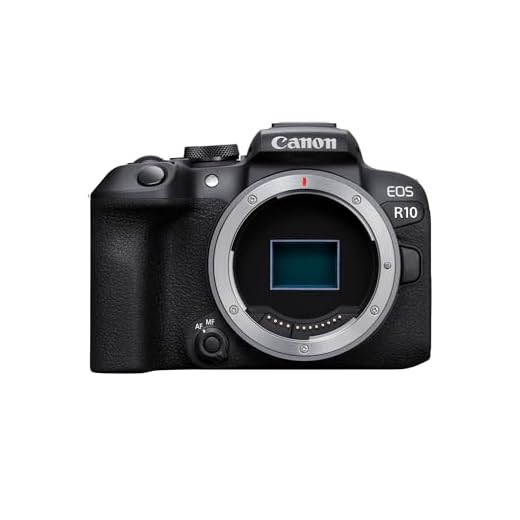Canon EOS R10 vs Nikon Z50
When comparing the Canon EOS R10 vs Nikon Z50, potential buyers will find both mirrorless cameras packed with features that cater to different photography needs. Both models offer significant advantages and distinct characteristics, making it essential to delve into the specifics to determine which camera suits your requirements best. In this comparison, we will explore key parameters such as design, optics, videography, battery life, and additional features to provide a comprehensive understanding of these two cameras.
Also see: Canon EOS R10 vs EOS RP


Comparison Table – Canon EOS R10 vs Nikon Z50
| Feature | Canon EOS R10 | Nikon Z50 |
|---|---|---|
| TYPE | Mirrorless | Mirrorless |
| VIEWFINDER | Electronic viewfinder (EVF) | Electronic viewfinder (EVF) |
| IS WEATHER-SEALED (SPLASHPROOF) | ✖ | ✔ |
| SCREEN RESOLUTION | 1040k dots | 1040k dots |
| EVF RESOLUTION | 2360k dots | 32k dots |
| HAS A BUILT-IN FOCUS MOTOR | ✖ | ✖ |
| HAS A FLIP-OUT SCREEN | ✔ | ✔ |
| VIEWFINDER COVERAGE | 100% | 100% |
| SCREEN SIZE | 3″ | 3.2″ |
| WEIGHT | 426.4 g | 395 g |
| HAS A TOUCH SCREEN | ✔ | ✔ |
| HAS A HOT SHOE | ✔ | ✔ |
| VOLUME | 897.01 cm³ | 709.66 cm³ |
| IS A SYSTEM CAMERA | ✔ | ✔ |
| HAS A FLASH | ✔ | ✔ |
| LOWEST POTENTIAL OPERATING TEMP | 0 °C | 0 °C |
| MAXIMUM OPERATING TEMP | 40 °C | 40 °C |
| HAS A TILTING VIEWFINDER | ✖ | ✖ |
| EVF REFRESH RATE (MAX) | Unknown | Unknown |
| WATERPROOF DEPTH RATING | Unknown | Unknown |
| WIDTH | 122.5 mm | 126.5 mm |
| HEIGHT | 87.8 mm | 93.5 mm |
| THICKNESS | 83.4 mm | 60 mm |
| SENSOR SIZE | APS-C | APS-C |
| LENS MOUNT | Canon RF | Nikon Z |
| FOCUS POINTS | 651 | 209 |
| MEGAPIXELS (MAIN CAMERA) | 24.2 MP | 20.9 MP |
| MAXIMUM ISO | 32000 ISO | 51200 ISO |
| MAXIMUM EXPANDED ISO | 51200 ISO | 204800 ISO |
| HAS SENSOR SHIFT STABILIZATION | ✖ | ✖ |
| CONTINUOUS SHOOTING (MECHANICAL) | 15 fps | 11 fps |
| HAS AF TRACKING | ✔ | ✔ |
| HAS PHASE-DETECTION AUTOFOCUS | ✔ | ✔ |
| FASTEST SHUTTER SPEED | 1/4000 s | 1/4000 s |
| HAS MANUAL FOCUS | ✔ | ✔ |
| HAS TOUCH AUTOFOCUS | ✔ | ✔ |
| HAS MANUAL SHUTTER SPEED | ✔ | ✔ |
| HAS A BUILT-IN HDR MODE | ✔ | ✔ |
| HAS A BSI SENSOR | ✖ | ✔ |
| HAS MANUAL EXPOSURE | ✔ | ✔ |
| HAS A TWO-STAGE SHUTTER | ✔ | ✔ |
| HAS A SERIAL SHOT MODE | ✔ | ✔ |
| HAS A CMOS SENSOR | ✔ | ✔ |
| HAS MANUAL ISO | ✔ | ✔ |
| FLASH SYNC SPEED | 1/250 s | 1/200 s |
| HAS MANUAL WHITE BALANCE | ✔ | ✔ |
| CAN CREATE PANORAMAS IN-CAMERA | ✔ | ✖ |
| EXPOSURE TIME | 30 s | 30 s |
| MAXIMUM ELECTRONIC SHUTTER SPEED | 1/4000 s | Unknown |
| SHUTTER LAG | 0.1 s | Unknown |
| EXPEED VERSION | Unknown | 6 |
| DIGIC VERSION | 10 | Unknown |
| HAS A STACKED CMOS SENSOR | ✖ | ✖ |
| CROSS-TYPE FOCUS POINTS | Unknown | Unknown |
| POWER-ON DELAY | Unknown | Unknown |
| PIXEL SIZE (MAIN CAMERA) | 3.72 µm | Unknown |
| CAN COMBINE IMAGE STABILIZATION | ✖ | ✖ |
| VIDEO RECORDING (MAIN CAMERA) | 2160 x 30 fps | 2160 x 30 fps |
| HAS PHASE-DETECTION AUTOFOCUS | ✔ | ✔ |
| HAS CONTINUOUS AUTOFOCUS | ✔ | ✔ |
| HAS A MICROPHONE INPUT | ✔ | ✔ |
| HAS A SOCKET FOR A 3.5 MM JACK | ✖ | ✖ |
| HAS A STEREO MICROPHONE | ✔ | ✔ |
| HAS TIMELAPSE FUNCTION | ✔ | ✔ |
| MOVIE BITRATE | 230 Mbps | 144 Mbps |
| NUMBER OF MICROPHONES | Unknown | 2 |
| HAS A 24P CINEMA MODE | ✔ | ✔ |
| SUPPORTS SLOW-MOTION VIDEO | ✖ | ✔ |
| BATTERY LIFE (CIPA) | 450 shots | 300 shots |
| HAS A REMOVABLE BATTERY | ✔ | ✔ |
| HAS A RECHARGEABLE BATTERY | ✔ | ✔ |
| HAS A BATTERY LEVEL INDICATOR | ✔ | ✔ |
| BATTERY POWER | 1040 mAh | 1120 mAh |
| SUPPORTS WI-FI | ✔ | ✔ |
| HAS BLUETOOTH | ✔ | ✔ |
| HAS DUAL CARD SLOTS | ✖ | ✖ |
| HAS PIXEL SHIFT SHOT | ✖ | ✖ |
| SHOOTS RAW | ✔ | ✔ |
| SUPPORTS LOSSLESS COMPRESSED RAW | ✔ | ✖ |
| WI-FI VERSION | Wi-Fi 4 (802.11n) | Wi-Fi 5 (802.11ac), Wi-Fi 4 (802.11n) |
| SUPPORTS A REMOTE SMARTPHONE | ✔ | ✔ |
| HAS AN HDMI OUTPUT | ✔ | ✔ |
| HAS GPS | ✖ | ✖ |
| HAS FIRST-PARTY SUPPORT FOR LIVE STREAMING | ✔ | ✖ |
| HAS AN ADVANCED HOT SHOE | ✔ | ✖ |
| DXOMARK SENSOR SCORE | Unknown | Unknown |
| DXOMARK SPORTS SCORE | Unknown | Unknown |
| DXOMARK LANDSCAPE SCORE | Unknown | Unknown |
| DXOMARK PORTRAIT SCORE | 14 bits | Unknown |
| USB VERSION | 2 | 2 |
| HDMI VERSION | Unknown | Unknown |
| HAS NFC | ✖ | ✖ |
| HAS AN EXTERNAL MEMORY SLOT | ✔ | ✔ |
| INTERNAL STORAGE | Unknown | Unknown |
| HAS USB TYPE-C | ✔ | ✖ |
| BLUETOOTH VERSION | 4.2 | 4.2 |
Design and Build
Starting with the design, both the Canon EOS R10 and Nikon Z50 are mirrorless cameras, offering a compact and lightweight alternative to traditional DSLRs. The Canon EOS R10 weighs 426.4 grams, while the Nikon Z50 is slightly lighter at 395 grams. Despite its lighter weight, the Nikon Z50 boasts a weather-sealed body, providing extra protection against dust, raindrops, and water splashes—a significant advantage for outdoor and adventure photographers. The Canon EOS R10, however, lacks this feature.
The screen resolution on both cameras is identical at 1040k dots, ensuring clear and sharp image reviews. Both models also feature a flip-out screen, which is highly useful for capturing tricky shots from various angles. The Canon EOS R10 has a 3-inch screen, whereas the Nikon Z50 offers a slightly larger 3.2-inch display, providing a more expansive view.
Viewfinder and Display
Both cameras are equipped with an electronic viewfinder (EVF) that covers 100% of the frame, ensuring precise composition. However, the Canon EOS R10 has a significant edge with its higher EVF resolution of 2360k dots compared to the Nikon Z50’s 32k dots. This difference can result in a clearer and more detailed view through the viewfinder, enhancing the shooting experience.
Optics and Performance
In terms of sensor size, both cameras feature an APS-C sensor, which is crucial for capturing high-quality images with improved low-light performance and dynamic range. The Canon EOS R10 has a higher megapixel count at 24.2 MP compared to the Nikon Z50’s 20.9 MP, potentially offering more detail in the images. However, the Nikon Z50 compensates with a higher maximum ISO of 51200, extending to an impressive 204800 ISO in expanded mode, compared to the Canon EOS R10’s maximum ISO of 32000 and expanded ISO of 51200.
Autofocus capabilities are another critical factor. The Canon EOS R10 provides 651 focus points, offering greater flexibility in selecting the focus area, whereas the Nikon Z50 has 209 focus points. Both cameras support phase-detection autofocus, ensuring fast and accurate focusing, especially in dynamic shooting scenarios.
Continuous Shooting and Shutter Speed
For action and sports photography, the continuous shooting speed is essential. The Canon EOS R10 excels with a mechanical shutter speed of 15 frames per second (fps), while the Nikon Z50 offers 11 fps. Both cameras share the same fastest shutter speed of 1/4000 seconds, enabling them to capture fast-moving subjects with minimal blur.
Videography
Videographers will appreciate the 4K video recording capabilities of both cameras. The Canon EOS R10 can record at 2160p at 30 fps, similar to the Nikon Z50. Both models feature phase-detection autofocus and continuous autofocus while recording, ensuring smooth and sharp videos even with moving subjects. The Canon EOS R10 has a higher movie bitrate of 230 Mbps, compared to Nikon Z50’s 144 Mbps, potentially offering better video quality with more details and fewer compression artifacts.
Battery Life and Connectivity
Battery life is another critical consideration. The Canon EOS R10 offers a longer battery life with a CIPA rating of 450 shots, whereas the Nikon Z50 provides 300 shots per charge. Both cameras have removable and rechargeable batteries with battery level indicators.
In terms of connectivity, both cameras support Wi-Fi and Bluetooth, allowing easy transfer of photos and videos to other devices. The Canon EOS R10 supports Wi-Fi 4 (802.11n), while the Nikon Z50 supports the newer Wi-Fi 5 (802.11ac) along with Wi-Fi 4, providing faster and more reliable wireless connections.
Additional Features
Both cameras have several additional features that enhance their usability. They support RAW image shooting, manual ISO, white balance settings, and built-in HDR mode. The Canon EOS R10, however, includes some unique features such as first-party live streaming support and an advanced hot shoe, making it more versatile for content creators.
In conclusion, the Canon EOS R10 and Nikon Z50 are both robust mirrorless cameras that offer excellent performance and features. The Canon EOS R10 stands out with its higher EVF resolution, more focus points, faster continuous shooting speed, and unique features like live streaming support. On the other hand, the Nikon Z50 offers advantages like weather sealing, higher maximum ISO, and a slightly lighter body. Your choice between the two will ultimately depend on your specific needs and preferences, whether you prioritize resolution, shooting speed, or durability.
Also See:
How to Buy a Mirrorless Digital Camera
Nikon Z6 II vs Nikon Z5 – Comprehensive Comparison
——————————————————————————————————————————————
Techcazt, Tech Magazine. We provide you with the latest news, reviews, and insights on the most cutting-edge technology available today. Whether you’re a hardcore gamer, a tech enthusiast, or just looking for great deals on your favorite gadgets, we’ve got you covered. The articles published in our magazine are intended to provide general information and ideas related to Tech and related topics. We strive to provide accurate and up-to-date information, but readers should always conduct their own research and consult with professionals before making decisions. If you have any comments or suggestions, please comment below. You can also follow us on Facebook, Instagram, and Twitter. Do not forget to give us a LIKE and SUBSCRIBE.



